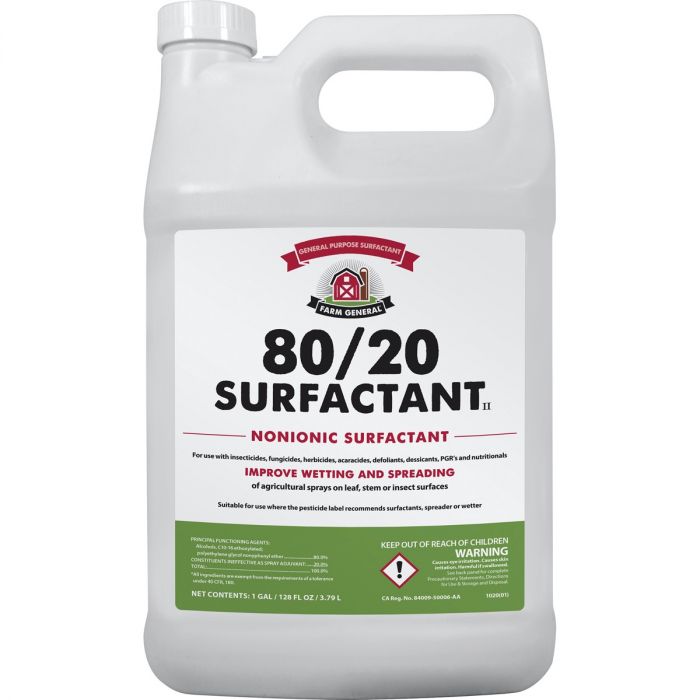80/20 Surfactant
Improve the wetting and spreading of spray solutions on leaf, stem or insect surfaces. The surface-active agents in 80/20 Surfactant are suitable for use wherever a pesticide label recommends a surfactant, spreader or wetter. The general purpose surfactant also contains a defoamer to help suppress the formation of foam in your spray solutions.
Non-ionic surfactant
Farm General 80/20 Surfactant is a general purpose non-ionic surfactant of the alcohol ethoxylate, alkylphenol ethoxylate type surface active agents.
It can be used with most insecticides, fungicides, herbicides, acaricides, defoliants, desiccants and wettable powders to improve performance of the active spray ingredient by giving them more uniform distribution and better wetting of the plant surface.
Where to use:
Use with insecticides, fungicides, herbicides, acaracides, defoliants, dessicants, PGR's and nutritionals
When to use:
- When the pesticide label recommends surfactants, spreader or wetter
- To improve wetting and spreading of agricultural sprays on leaf, stem or insect surfaces
How to use:
Always read and follow the label of the pesticide(s) and additive(s) to be used with this product. Always refer to the pesticide and additive label(s) for additional directions or precautions. Follow the most restrictive label.
| Applications | This Product per 100 Gals. of Mix |
| Acaricides | 1 to 2 pts. |
| Defoliants | 1 to 2 pts. |
| Desiccants | 1 to 2 pts. |
| Foliar nutrients | 1 to 2 pts. |
| Fungicides | 1 to 2 pts. |
| Herbicides | 1 to 2 pts. |
| Insecticides | 1 to 2 pts. |
| Plant Growth Regulator (PGR) | 1 to 2 pts. |
| Wettable powders | 1 to 2 pts. |
Variations in conditions of use can cause some variation in the amount of this product required. The minimum required to give a smooth, uniform coverage usually gives the most effective results. Not for aquatic use.
MIXING INSTRUCTIONS
For wettable powders and water-soluble materials, add this product in water before adding pesticide to spray tank. For emulsifiable products, add this product after a good emulsion is formed.
Active Ingredients:
| Alcohols, C10-16 ethoxylated; polyethylene glycol nonyphenyl ether | 80.0% |
| Constituents ineffective as spray adjuvants | 20.0% |
| Total: | 100.0% |
All ingredients are exempt from the requirements of a tolerance under 40 CFR, 180.
Product Label:
Disclaimer:
It is a violation of Federal law to use this product in a manner inconsistent with its labeling. Read the entire label before each use. Use only according to label instructions.
See the complete label for specific use rates and detailed instructions.
Consult the Safety Data Sheet (SDS) for important safety information.

